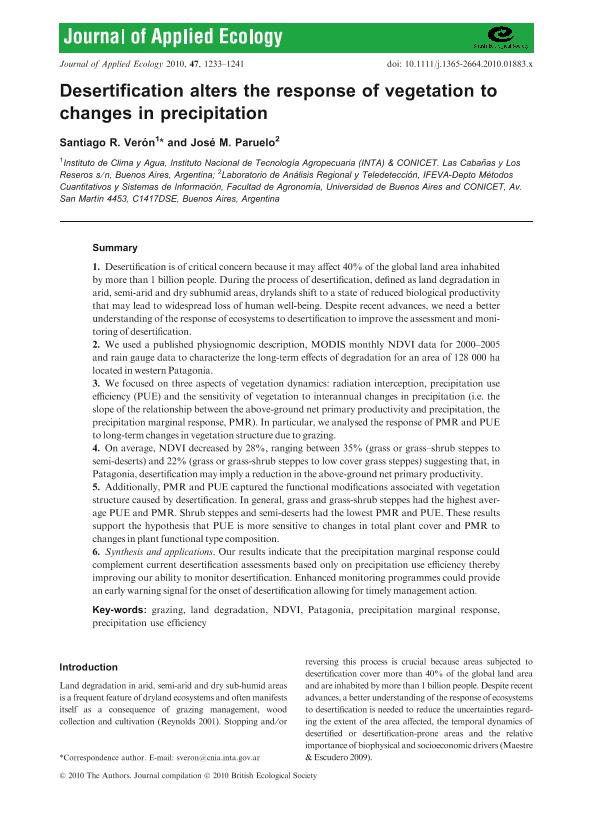Artículo
Desertification alters the response of vegetation to changes in precipitation.
Fecha de publicación:
01/2010
Editorial:
Wiley Blackwell Publishing, Inc
Revista:
Journal of Applied Ecology
ISSN:
0021-8901
Idioma:
Inglés
Tipo de recurso:
Artículo publicado
Clasificación temática:
Resumen
1. Desertification is of critical concern because it may affect 40% of the global land area inhabited by more than 1 billion people. During the process of desertification, defined as land degradation in arid, semi-arid and dry subhumid areas, drylands shift to a state of reduced biological productivity that may lead to widespread loss of human well-being. Despite recent advances, we need a better understanding of the response of ecosystems to desertification to improve the assessment and monitoring of desertification. 2. We used a published physiognomic description, MODIS monthly NDVI data for 2000-2005 and rain gauge data to characterize the long-term effects of degradation for an area of 128 000 ha located in western Patagonia. 3. We focused on three aspects of vegetation dynamics: radiation interception, precipitation use efficiency (PUE) and the sensitivity of vegetation to interannual changes in precipitation (i.e. the slope of the relationship between the above-ground net primary productivity and precipitation, the precipitation marginal response, PMR). In particular, we analysed the response of PMR and PUE to long-term changes in vegetation structure due to grazing. 4. On average, NDVI decreased by 28%, ranging between 35% (grass or grass-shrub steppes to semi-deserts) and 22% (grass or grass-shrub steppes to low cover grass steppes) suggesting that, in Patagonia, desertification may imply a reduction in the above-ground net primary productivity. 5. Additionally, PMR and PUE captured the functional modifications associated with vegetation structure caused by desertification. In general, grass and grass-shrub steppes had the highest average PUE and PMR. Shrub steppes and semi-deserts had the lowest PMR and PUE. These results support the hypothesis that PUE is more sensitive to changes in total plant cover and PMR to changes in plant functional type composition. 6. Synthesis and applications. Our results indicate that the precipitation marginal response could complement current desertification assessments based only on precipitation use efficiency thereby improving our ability to monitor desertification. Enhanced monitoring programmes could provide an early warning signal for the onset of desertification allowing for timely management action. © 2010 The Authors. Journal compilation © 2010 British Ecological Society.
Archivos asociados
Licencia
Identificadores
Colecciones
Articulos(IFEVA)
Articulos de INST.D/INV.FISIOLOGICAS Y ECO.VINCULADAS A L/AGRIC
Articulos de INST.D/INV.FISIOLOGICAS Y ECO.VINCULADAS A L/AGRIC
Citación
Verón, Santiago Ramón; Paruelo, José; Desertification alters the response of vegetation to changes in precipitation.; Wiley Blackwell Publishing, Inc; Journal of Applied Ecology; 47; 6; 1-2010; 1233-1241
Compartir
Altmétricas




